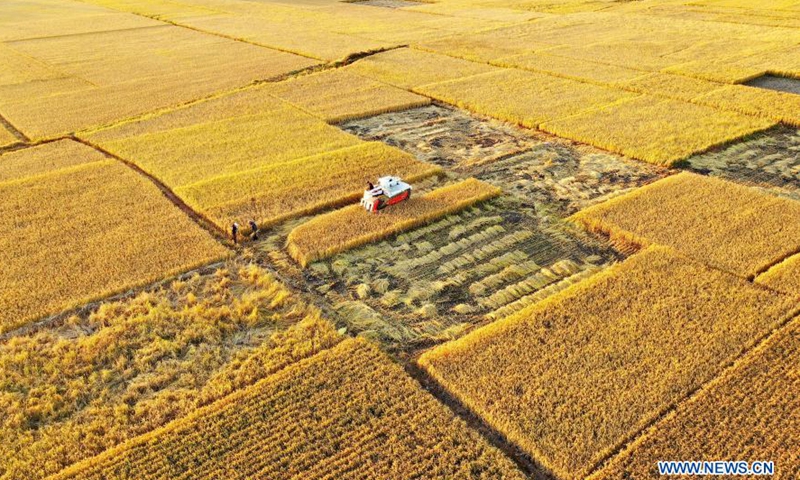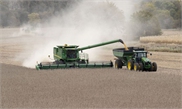
Aerial photo taken on Oct. 18, 2020 shows harvesters operating in rice fields at Jiangzhuang Village of Luanzhou City in north China's Hebei Province. China's grain output reached nearly 670 billion kg in 2020, up 5.65 billion kg, or 0.9 percent, from last year, the National Bureau of Statistics (NBS) said on Thursday. This marks the sixth consecutive year that the country's total grain production has exceeded 650 billion kg. The bumper harvest comes despite disrupted farming as a result of the COVID-19 epidemic, which has been held in check thanks to efforts to ensure the transportation of agricultural materials and strengthen farming management.Photo:Xinhua
China vows to solve seeds and arable land issues, and has put ensuring grain safety as one of the priorities in the Central Economic Work Conference which ended on Friday in Beijing.
China needs to enhance seed quality resources' protection and utilization and enhance the construction of seed banks, the meeting said, explaining that China should improve technical research of seed sources, as "this is also the bottleneck,"
"China vow to solve seeds and arable land issues shows the central government's determination to ensure food safety," Ma Wenfeng, a senior analyst at the Beijing Orient Agribusiness Consultancy, told the Global Times on Friday.
He explained China's grain yield gap such as corn and soybeans compared to other countries is wider, and it is urgent for China to improve such technology.
The yield for corn in China in 2002 was about 60 to 90 percent that of the US, but the rate has dropped to half last year. The yield for soybeans has not improved in the past 20 years, resulting in large grain imports, he said.
Experts said China has a vast territory with rich biodiversity, and there have been good seed resources for a long time. However, there is a trend now that a large number of seeds are imported from abroad or foreign companies provide seeds, and many "native seeds" in China are eliminated by hybridization or genetic modification as these "native seeds" have low yields.
It is worth noting that from a scientific and genetic point of view, these "native seeds" have a value that cannot be ignored, experts said.
The meeting also said that it is necessary to firmly hold the red line of 1.8 billion mu (120 million hectares) of total arable land.
Efforts should be made to avoid using farmland for purposes other than growing grain and to pursue stable food production, according to a circular issued by the General Office of the State Council on November 17.
Prior to that, the State Council issued a circular on September 15 requiring efforts to implement the strictest farmland protection to prevent non-agricultural activities on farmland and to resolutely defend the red line.
Analysts said that the current external situation has undergone major changes, and there is a tense trend in the international food environment, which is why prevention of "de-grainization" of cultivated land has been given priority.
So far, China's grain sector has had no import dependency problem. In 2019, the self-sufficiency rate of China's three major staple grains of rice, wheat and corn reached 98.75 percent, data from an industry report showed.
However, when all grain is taken into account, China's self-sufficiency rate is about 85 percent. And imports of feed grain for the production of meat, eggs and milk will continue to increase in the future.
The Chinese Academy of Social Sciences predicted that by the end of the 14th Five-Year Plan period (2021-2015), China may have a food shortage of about 130 million tons.
China imported 4.79 million tons of corns in 2019, a year-on-year increase of 36 percent, data from Ministry of Agriculture and Rural Affairs showed.

